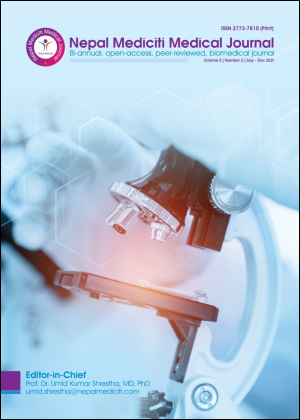Quick-Wee method Versus Standard method for urine collection in infants 1-12 month old
DOI:
https://doi.org/10.3126/nmmj.v2i2.41276Keywords:
Clean catch urine collection, infants, Quick-Wee method, Urinary tract infectionAbstract
BACKGROUND: Urinary Tract infections [UTI] often presents with fever and nonspecific findings in infants less than one year. So urine sample collection is mandatory for diagnosis or exclusion. Collecting Urine sample is very challenging in infants and choosing the method of collection must balance the reliability, speed and contamination. Clinical guidelines have different recommendations so there is a need for reliable collection method. Therefore this study was conducted to determine if a simple stimulation method (Quick–wee Method) increases the rate of clean catch voiding of urine within five minutes.
METHODS: A prospective age and sex matched case control study in 1-12 months children conducted from June 2017 – June 2018 in Pediatric ward of Manipal college of medical sciences, Pokhara, after Ethical clearance from Institutional review Board [IRB]. The study population was randomized to either clean catch midstream urine with stimulation [Quick–Wee method] or without stimulation [Standard method]. The primary outcome was voiding of urine within 5 minute. Secondary outcome were waiting time for voiding, successful collection, parental satisfaction, and contamination. The analysis was done using SPSS version 20 and a ‘p’value <0.05 was considered statistically significant.
RESULTS: Waiting time for voiding in Quick wee group was less and statistically significant compared to standard group. There was 10% increment in voiding within 5 minutes in Quick wee group . It had higher successful urine collection rate (91.4%), slightly higher contamination rate (14.28%) but better parental satisfaction.
CONCLUSIONS: Quick wee method is easy, reliable, successful method of urine collection in infants with better parental satisfaction and slightly higher contamination rate.
Downloads
Downloads
Published
How to Cite
Issue
Section
License
Copyright (c) 2021 Nepal Mediciti Medical Journal

This work is licensed under a Creative Commons Attribution 4.0 International License.
This license enables reusers to distribute, remix, adapt, and build upon the material in any medium or format, so long as attribution is given to the creator. The license allows for commercial use.

